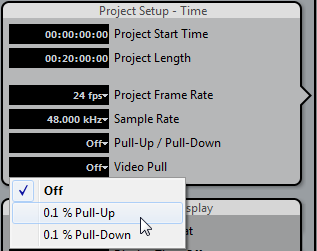Video Pull-Up and Pull-Down
Nuendo also provides a method to adjust for film transfers by speeding up or slowing down playback of the video files in your project.
Depending on the situation, it can be helpful to make the video file play back at film speed and not adjust the audio playback at all.
Adjusting the video playback speed back to film reverses the process used when adjusting audio playback speed. For NTSC video, the video playback speed must be adjusted up +0.1 % back to film speed.
Altering the video playback speed is done in the Project Synchronization Setup dialog (Project Setup - Time section). You have 2 options: 0.1 % pull-up and 0.1 % pull-down.

Video +0.1 % Pull-Up for NTSC
Because NTSC video is running -0.1 % slower than the original film, pulling the video speed back up by +0.1 %, returns it to original film speed. With the video now running at the correct film speed, audio originally recorded at 48 kHz on the film shoot will remain in sync with the video. Additionally, the final mix can be digitally transferred back to film at 48 kHz without the need for an analog copy or sample rate conversion.
Video -0.1 % Pull-Down (Non-Standard)
Pulling the video speed down for an NTSC video is a non-standard procedure and would not happen under normal circumstances. It is possible to pull down a video file that is running at 24 fps -0.1 % so it matches with material running at NTSC video speed. The resulting frame rate is 23.976 fps.
Speeding up or slowing down the video speed is only possible if the video is running through a computer video card. If a professional genlocked video card is used, the video playback speed is derived from the genlock input.
What is 23.976 fps Used for?
The world of digital video formats is ever changing and the results are new developments for every media professional involved in movies, television, corporate video, and more. With the advent of HD cameras that are capable of recording at several different frame rates internally, the options available to cinematographers have become staggering.
Because the look of film running at 24 fps is unique, many HD productions are filmed at 24 fps to mimic the look of film on video. Because the speed change from 24 fps to 29.97 fps NTSC is such an odd one (requiring the 0.1 % pull-down), designers of these cameras have developed a method of recording that allows the camera to record like film, but also output an NTSC video signal at the same time without any speed change. They record at 23.976 fps which translates to 24 fps pulled down -0.1 %.